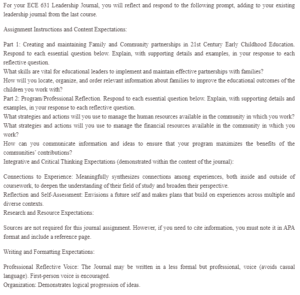Building Strong Partnerships in the 21st Century Early Childhood
Part 1: Creating and Maintaining Family and Community Partnerships in 21st Century Early Childhood Education
Vital Skills for Educational Leaders to Implement and Maintain Effective Partnerships with Families
Relational Skills
Educational leaders must possess relational skills that enable them to interact with parents from different backgrounds. There is a need to communicate with parents on issues related to the partnerships. Besides relational skills, leaders must also be sensitive to the different cultures their parents belong to. As a result, cultural sensitivity will improve the interactions between the leaders and the parents (Perras, 2020).
Do you need urgent assignment help ? Contact us. We are determined to provide you with excellent service.
Conflict Resolution and Information Sharing
Conflict resolution capability is essential in a learning environment because disagreements always arise. A framework for resolving these conflicts is crucial in ensuring that the relationship between teachers and parents does not sour (American Management Association, 2021). In addition to resolving conflict, proper communication skills are critical for increased effectiveness. The leaders need to choose the most effective modes of communication. Alongside communication, the leaders must also be willing to share information as it comes up openly. Sharing this information should promote proper communication and reduce conflict (Perras, 2020).
Inclusivity and Transparency
The leaders should also be capable of including all the parents regardless of their differences. Inclusivity is likely to promote collaboration, especially when decisions must be made. At this point, the leaders would also be required to include the parents in the decision-making process. In addition, leaders need to be transparent about the information they obtain from different sources. Such transparency should, in turn, promote trust among the main stakeholders (Perras, 2020).
Locating, Organizing, and Ordering Relevant Information about Families
Relevant information is critical when improving children’s educational outcomes. Therefore, the parents would be asked to provide statements they believe voluntarily affect their children’s learning outcomes. Children’s children would be engaged in sit-down discussions of their performance in the presence and absence of their parents. Most of the information is likely obtained from the meeting held without parents. Children’s reasons for their performance can then be communicated to parents for change or improvement.
Part 2: Program/Professional Reflection
Strategies and Actions for Managing Human Resources
Human resources are necessary for maintaining the workflow of the parent-teacher partnerships. The local human resources will be contracted based on their skills. For instance, sound engineers, outside caterers, and event organizers will be employed to ensure that meetings and events are well-catered. Accordingly, these contracts will be renewed based on performance.
Strategies and Actions for Managing Financial Resources
The available financial resources will be managed using budgets. The budgets created for the projected meetings and activities will guide the allocation of resources. As a result, this strategy will eliminate any unnecessary spending that may occur without adhering to the budget. The use of budgets will also increase the efficiency of the planning processes.
Effective Communication to Ensure the Program Maximizes the Benefits of the Communities’ Contributions
Information will be communicated in varioCommunities’nsure it reaches all stakeholders. For instance, parents will receive emails about upcoming meetings and activities. The community stakeholders will have access to posters with similar details in the locality’s common areas. The faculty members wilocality’srmed of such events through internal memos. The meetings will provide a platform for interactive communication because parents can ask questions and obtain clarification regarding specific issues. The stakeholders will also be encouraged to make calls for discussions on particular topics. These modes of communication should promote information sharing, inclusivity, transparency, and shared decision-making.
References
American Management Association. (2021). The Five Steps to Conflict Resolution. Retrieved from https://www.amanet.org/articles/the-five-steps-to-conflict-resolution/
Perras, C. (2020). Effective Parent-Teacher Partnerships: Considerations for Educators.
ORDER A PLAGIARISM-FREE PAPER HERE
We’ll write everything from scratch
Question 
For your ECE 631 LeadeWe’ll Journal, you will reflect and respond to the following prompt, adding to your existing leadership journal from the last course.

Building Strong Partnerships in the 21st Century Early Childhood
Assignment Instructions and Content Expectations:
Part 1: Creating and maintaining Family and Community partnerships in 21st Century Early Childhood Education. Respond to each essential question below. Explain, with supporting details and examples, in your response to each reflective question.
What skills are vital for educational leaders to implement and maintain effective partnerships with families?
How will you locate, organize, and order relevant information about families to improve the educational outcomes of the children you work with?
Part 2: Program/Professional Reflection. Respond to each essential question below. Explain, with supporting details and examples, in your response to each reflective question.
What strategies and actions will you use to manage the human resources available in the community in which you work?
What strategies and actions will you use to manage the financial resources available in the community in which you work?
How can you communicate information and ideas to ensure that your program maximizes the benefits of the communities’ contributions?
Integrative and Critical Thinking Expectcommunities’nstrated within the content of the journal):
Connections to Experience: Meaningfully synthesizes connections among experiences, both inside and outside of coursework, to deepen the understanding of their field of study and broaden their perspective.
Reflection and Self-Assessment: Envisions a future self and makes plans that build on experiences across multiple and diverse contexts.
Research and Resource Expectations:
Sources are not required for this journal assignment. However, if you need to cite information, you must note it in APA format and include a reference page.
Writing and Formatting Expectations:
Professional Reflective Voice: The Journal may be written in a less formal but professional voice (avoids casual language). First-person voice is encouraged.
Organization: Demonstrates logical progression of ideas.